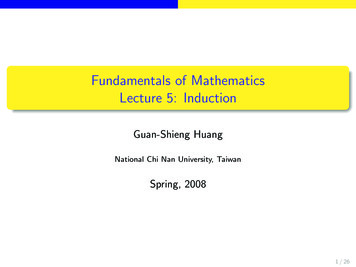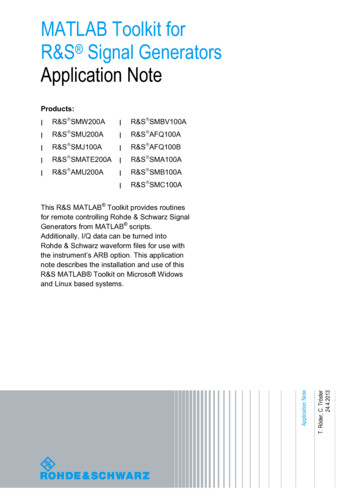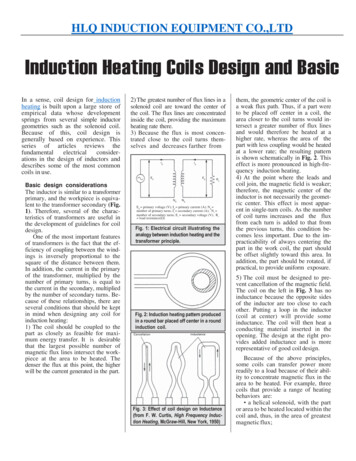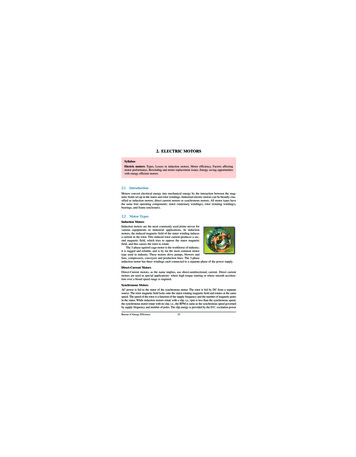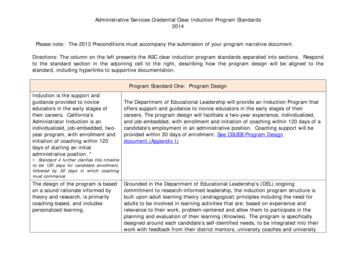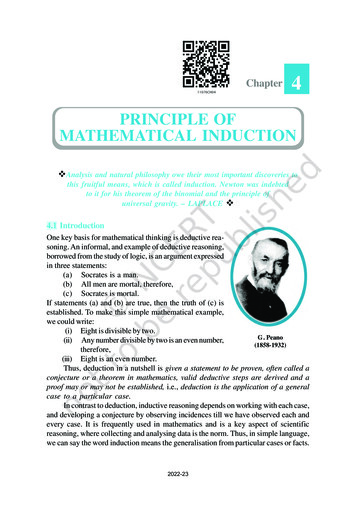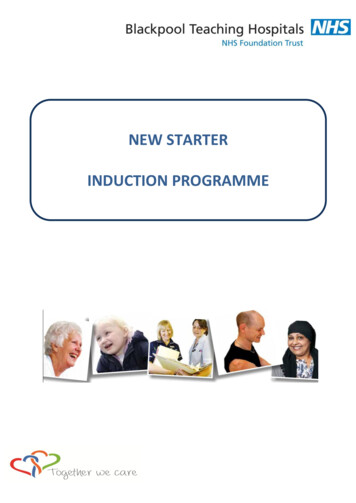
Transcription
Teacher Induction and a Toolkit forAdult EducatorsJuly 2015
ContentsPageBackground and Acknowledgments . ivWhat Is Teacher Induction? .1The Adult Education Teacher Induction Toolkit .3The Purpose .3The Team .3The Teacher Induction Pathway .6The Tools.11References .14LINCSTeacher Induction and a Toolkit for Adult Educators—iii
Background and AcknowledgmentsThe U.S. Department of Education, Office of Career, Technical, and Adult Education(OCTAE)—through a contract a with the American Institutes for Research and its partners WorldEducation, Inc., and Drennon and Associates—created the Promoting Teacher Effectiveness inAdult Education Project to help improve the quality of adult education teachers in the UnitedStates. One goal of the project was to develop an adult education Teacher Induction Pathwaythat helps beginning adult education teachers become experienced teachers, and helpsexperienced teachers become mentor teachers. The Adult Education Teacher Induction Toolkitthat emerged from this project is described in this brief. The toolkit was field tested with eightadult education programs around the country in 2013–14. The contribution of the 46 peopleinvolved was immeasurably important to the development of this toolkit: Canton City Schools Adult Basic and Literacy Education: Heidi Daniels,Jennifer Everetts, and Jane Meyer Elgin Community College: Sarah Burkhart, Josephine Cammallarie, Rose Dunphy,Andrea Fiebig, Sally Guy, Elizabeth Hobson, Elizabeth McNulty, and Karen Voo Heartland Community College: Kym Ammons-Scott, Jill Blair, Sarah Dalton,May Favis, Rhonda Glan, Starr Gobtop, Donielle Sharma, Tammy Truitt, Kerry Urquizo,and John Zimmerman Huntington Beach Adult School: Pamela Canlas, Steve Curiel, Robby Esquerre,Tracy Foreman, and Keith Meginley Lewis and Clark Community College: Barb Dorris, Valerie Harris, Vicki Hinkle,Julie McAfoos, Marsha Morgan, Marilyn Schmidt, Sheila Vaughn, Monica Waller, andNancy Young Rhode Island Family Literacy Initiative: Larry Britt, Lauren Lancaster, Sherry Lehane,Emily Schwab, and Karisa Tashjian Tempe Adult Education Program: Lynette Quinones, Vanda Salls, andMaria Spurgeon Ventura Adult and Continuing Education: Crystal Cahuantzi, Heidi Sohn, andSteve ThompsonaThese materials were developed by American Institutes for Research (AIR), in partnership with the Office ofCareer, Technical, and Adult Education of the U.S. Department of Education, as part of the Promoting TeacherEffectiveness in Adult Education Project (ED-CFO-10-A-0066). Patricia Bennett was the Contract OfficerRepresentative for this project. The views expressed herein do not necessarily represent the positions or policies ofthe Office of Career, Technical, and Adult Education or the U.S. Department of Education. No official endorsementof any product, commodity, service, or enterprise mentioned in this material is intended or inferred.LINCSTeacher Induction and a Toolkit for Adult Educators—iv
What Is Teacher Induction?What kind of professional development supports the greatest growth for adult educators? Aninvestment in mentoring programs and induction models that support ongoing dialogue andcollaboration among teachers is shown to have impact beyond more traditional and often typicalone-shot workshops. 1 New teachers experience a sharp learning curve as they discover how tonavigate the demands of their classrooms and schools throughout their first years of teaching.The Alliance for Excellent Education found that beginning teachers need between 3 and 7 yearsto become effective teachers who maximize student performance. 2 Many adult educationteachers face the additional challenge of not having access to a strong preservice training periodor to formal education in the necessary core content and instructional methods that are mosteffective with adult learners.In kindergarten through Grade 12 (K–12), a growing number of professional learning programsacross the country are designed to offer “support, guidance, and orientation for beginningteachers during the transition into their first teaching job.” 3 These support efforts are known asinduction programs. (In 2001, 33 states had policies on induction. 4 This number seems to haveremained roughly constant in more recent years. 5)Induction programs are a professional development model designed to provide mentor-basedsupport to beginning teachers and create a supportive climate for teacher growth anddevelopment. These programs help teachers through their first years, accelerate teachereffectiveness, and increase student achievement.The definition of this and other terms relevant to teacher induction can be found in the Teacher EffectivenessGlossary.Much of the research on induction has been done in the K–12 context. But adult educationteachers experience similar sharp learning curves and relative isolation in their first years ofteaching adults, particularly because few adult educators have formal teacher education,preservice training, or collegial support in their first adult education teaching experience. TheAnnotated Bibliography created through the Promoting Teacher Effectiveness in AdultEducation project and included as part of the Adult Education Teacher Induction Toolkithighlights research and literature on teacher induction and effectiveness.Cherubini describes a study that followed 175 beginning teachers in Ontario, Canada, duringtheir first 2 years as teachers. 6 The study focused on the impact of induction on professionalrelationships, and found that these relationships build “professional trust” in beginning teachers.The beginning teachers described instructional leaders in their professional lives as people“expressing a vested interest” in development. 7 As a result of their interactions with instructionalleaders, beginning teachers reported feeling that “the profession is actually manageable andenjoyable.” 8 One teacher described the power of induction models with this simple statement, “Itmakes you want to stay.” 9LINCSTeacher Induction and a Toolkit for Adult Educators—1
Although induction programs are specifically intended to help beginning teachers, ifimplemented well, these programs can have far-reaching benefits for programs and learners.Research in the K–12 context has consistently shown that teachers who participate in inductionprograms are less likely to leave the profession and are more likely to stay at the same schoolbeyond their first year of teaching. 10,11,12,13,14,15 By implementing an induction program, schooland adult education leaders can systematically promote greater teacher retention and reduceteacher attrition rates. With more effective teachers available, students in high-poverty and highminority schools and programs, which traditionally are staffed by newer, less-experiencedteachers, will have opportunities to learn from skilled teachers who are better prepared to helpclose the achievement gap. 16Induction models vary greatly, but the comprehensive models on which the Adult EducationTeacher Induction Toolkit was built generally have the following components: 17,18,19 Program vision that promotes high-quality instruction by teachers to support theachievement of students, which is the main purpose of an induction program. To do this,a program’s leaders and stakeholders must shape the induction program around centralquestions, such as “what is our vision for teachers and students . . . [and] how will this[induction] program help realize this vision.” 20 High-quality mentoring that is structured “from a carefully selected teacher or teacherswho work in the same field or subject as the new teacher, are trained to coach newteachers, and can help improve the quality of teachers’ practice.” 21 Ongoing professional development that is specifically designed to improve a teacher’sability to address the learning needs of students by (a) increasing the teacher’s contentknowledge and ability to teach literacy and numeracy, meet diverse learning needs, andmanage student behavior; and (b) assuring that teachers have the knowledge and abilitiesin the instructional practices associated with teacher competencies, like the AdultEducation Teacher Competencies. A supportive network that provides new teachers with a sense of community, belonging,and ongoing support. Assessment that is usually conducted through observation and an examination of studentdata. The assessment should be designed to determine how new teachers are progressingand to identify the areas in which they need more support to develop their skills. Selfassessment is also a feature of the induction process.The remainder of this brief provides an overview of the Adult Education Teacher InductionToolkit. It describes the purpose of the Toolkit, the roles and responsibilities of the differentmembers of the team that uses the Toolkit, the Teacher Induction Pathway through which theteam moves with the help of the Toolkit, and the tools that make up the Toolkit.LINCSTeacher Induction and a Toolkit for Adult Educators—2
The Adult Education Teacher Induction ToolkitThe PurposeThe Adult Education Teacher Induction Toolkit (the Toolkit) is designed to support a program’sability to offer evidence-based instruction that is aligned with the goals and objectives of theprogram. This is achieved by strengthening the instruction of beginning teachers by pairing themwith an experienced teacher who is trained as a mentor. Beginning teachers are those who arenew to the field of adult education (i.e., have fewer than 3 years of experience in adult education)or who are teaching a new subject area. Evidence-based instruction includes instructionalpractices in reading, writing, numeracy, and/or English language that are based on a body ofresearch and/or practitioner wisdom. The Toolkit can also be used to support induction into aneducation reform or new program initiative, such as using standards-based instruction, integratededucation and training, or career pathways.Although the induction pathway is primarily about the work done between the mentor andbeginning teacher, the guidance and support of an instructional leader is essential to success.Therefore, the Toolkit is designed to provide tools that can help Beginning teachers deliver evidence-based instruction in their classrooms Experienced teachers mentor beginning teachers Instructional leaders guide and support the induction pathway as a wholeFor this induction pathway to be successful, several program factors should be in place. Conditionsfor Success in Teacher Induction provides a detailed overview of conditions for program leaders toconsider as they determine their programs’ readiness for implementation. Although some programconditions may not be in place when induction begins, they ensure that teachers have the supportsfor induction and to grow as professionals.The TeamThree key roles are required for induction: Instructional leader (who may be the program’s lead administrator or another lead staffmember, such as an English for Students of Other Languages Coordinator) Mentor Beginning teacherThe program staff who take on these roles comprise the team for the induction process. Theprocess may take up to 9 months to complete. Because the Toolkit is designed to be flexible andadaptable, team members can decide to reduce or increase the amount of time for the processdepending on the needs of the individual program.The main purpose of the team is to provide beginning teachers with ongoing support and a venueto examine instructional practices and student learning. Each team member plays a specific roleand conducts activities that are guided by the materials in the Toolkit. Although each teamLINCSTeacher Induction and a Toolkit for Adult Educators—3
member has unique responsibilities, all contribute to the development and functioning of theteam throughout the process. Based on findings from research and the field test, certain keyattributes are essential to each role. Table 1 identifies the responsibilities for each team memberand the accompanying attributes that help the team members be more successful in those roles.Table 1. Roles and Responsibilities Within the Process and Attributes for leader Creates an environment that fosters thesuccess of mentors and beginningteachers throughout the inductionprocess Has a vision for the direction of theprogram and the quality of instructionas a whole, and is able to execute aplan to meet that vision, includinginduction Establishes a supportive climate bydetermining whether the necessaryConditions for Success in TeacherInduction are in place, identifyingbarriers, and then working to removethose barriers Becomes familiar with the LeadershipGuide for Teacher Induction andMentoring Guide for TeacherInduction so that he or she develops afirm understanding of what thementors and beginning teachers needto do Recruits experienced teachers to serveas mentors and matches them withbeginning teachers Ensures that mentors are well-trained Supports the planning for andimplementation of the inductionprocess Advocates for his or her mentors andbeginning teachers with stakeholdersoutside of the instructional unit,seeking and securing release time,funding, and other resources that willbe needed throughout the inductionprocess Cultivates the external stakeholders’understanding of the value of andbenefits from the induction andmentoring experiences, which iscritical for establishing aninstructional environment thatsupports the induction efforts Identifies potential challenges andobstacles and continually works withmentors and beginning teachers tosolve problems and move pastobstacles during the induction process Clarifies the priorities of the programfor the beginning teacher’scompetency self-assessment Secures release time, funding, and otherresources that mentors and beginningteachers need to conduct their activities(For details and step-by-step support forinstructional leaders throughout theinduction process, refer to the LeadershipGuide for Teacher Induction)LINCSTeacher Induction and a Toolkit for Adult Educators—4
RoleMentorResponsibilitiesAttributes Guides one or more beginning teachersin evidence-based instructionalpractices, through demonstration,observation, feedback, and supportedreflection Becomes familiar with the mentoringmaterials and protocols in the Toolkit Establishes a trusting relationship andcommunicates openly with beginningteachers Supports beginning teachers by: Developing a professional learningplan that is based on the selfassessment Documenting and reflecting onprofessional learning activities Sharing learning experiences withpeers Models and guides practice inevidence-based instruction Is an experienced and exemplaryteacher Fosters professional growth inbeginning teachers by sharing theknowledge and insights that he or shehas learned over time Is a content expert in the subject inwhich he or she teaches Models evidence-based instructionalpractices Has received training in mentoring(For a detailed description of the qualitiesand attributes that will enable anexperienced teacher to be a successfulmentor, refer to the “Selecting andMatching Participants for the TeacherInduction Pathway” section in theReadiness step of the Leadership Guidefor Teacher Induction) Helps beginning teachers to understandand navigate the program environment Observes and provides constructivefeedback to beginning teachers basedon their professional learning goals Assesses his or her mentoring skillsand plans for his or her ownprofessional learning(For details and step-by-step support formentors throughout the induction process,refer to the Mentoring Guide for TeacherInduction)LINCSTeacher Induction and a Toolkit for Adult Educators—5
RoleBeginningteacherResponsibilitiesAttributes Engages in a process of guidedreflection to understand his or herstrengths and weaknesses and refineand improve his or her instructionalpractices Develops a professional learning planbased on the Adult Education TeacherCompetencies Self-Assessment Steps out of his or her comfort zone totry new practices while beingobserved and receiving constructivefeedback Is receptive and eager to learn aboutand try new, evidence-basedinstructional practices Observes his or her mentor in theclassroom Reflects on and refines his or herinstructional practices throughout theinduction process Plans and conducts instruction that isbased on evidence-based instructionaltechniques Is open to constructive feedback andapplies it to his or her instructionalpractices Plans instruction that will be observedby his or her mentor Engages in ongoing self-assessmentand reflection Documents and reflects onprofessional learning activities Shares learning experiences with peers(For details and step-by-step support forhow beginning teachers work with theirmentors throughout the induction process,refer to the Mentoring Guide for TeacherInduction.)The Teacher Induction PathwayA sufficient amount of time is needed to go through the various steps and activities of theTeacher Induction Pathway (the Pathway) and to ensure that teachers have adequate time tolearn new content, plan their activities, observe other classrooms, and implement newly learnedinstructional approaches. Based on experience in the field test, the Toolkit recommends a teacherinduction pathway take place over a program year (up to approximately 9 months). However,because the Toolkit is designed to be flexible and adaptable, team members can decide to reduceor increase the overall amount of time for the induction process depending on their needs and thecontext of the specific program. Adult education programs that have used the Toolkit haveadapted its materials to fit their needs, expertise, and context while still engaging in keyactivities: regularly scheduled team meetings, classroom instruction and observation, andongoing planning and reflection.LINCSTeacher Induction and a Toolkit for Adult Educators—6
Thoughts From the Field Test“This toolkit helped my program to offer meaningful, effective professional development opportunitiesfor both new and experienced instructors. It also led to programmatic level changes that were based onevidence coming directly from the classroom. After being a part of the pilot, we utilized several piecesof the toolkit to design an instructor development and evaluation system that will expand to our entirestaff and will lead to continuous improvement for all.”—Heartland Community College“We used the resources in the toolkit to customize a mentoring program that works for our program.We created a 6 month mentoring plan that includes the videos and the readings along with classroomobservations and coaching. We tailored some of the forms to meet our needs. The information on howto mentor and observation techniques were especially helpful to us in getting started.”—Canton City Schools Adult Basic and Literacy EducationThe Teacher Induction Pathway provides a framework for induction with six steps: Readiness,Planning, Learning, Preparing, Applying and Reflecting. Supported by the instructional leader,mentors engage beginning teachers in learning new concepts and instructional practices and thentrying those practices in the classroom. Figure 1 shows the typical sequence and timeline for themain activities in the teacher induction pathway over the course of 9 months.LINCSTeacher Induction and a Toolkit for Adult Educators—7
Figure 1. The Teacher Induction PathwayLINCSTeacher Induction and a Toolkit for Adult Educators—8
Readiness. Before the induction process begins, instructional leaders should understandwhat induction is, how it connects to the goals of their program, and whether theirprogram is ready to implement it. This assessment can take place at any time before theplanned induction period. Key activities include the following:The program administrator reads Conditions for Success in Teacher Induction, assessesreadiness and potential barriers, and decides whether to implement the induction process.The program administrator identifies the person who will lead the induction process, afterreferencing “The Team" section in this brief and the Leadership Guide for Teacher Induction.The program administrator may serve as the instructional leader or choose another key staffperson to serve this role.The instructional leader identifies how the pathway can support induction into the program’sinitiative or to the desired content.The instructional leader helps to identify, recruit, select, and match the mentors and beginningteachers for the induction process, after referencing the “Selecting Participants for theInduction Process” section in the Leadership Guide for Teacher Induction. Planning (approximately Month 1). Team members do background reading andpreliminary planning to build their knowledge of the key concepts of teacher inductionand the specific processes of the Toolkit. Key activities include the following:Mentors prepare for their role by reviewing resources in the Mentoring Guide for TeacherInduction.All team members read and discuss the information briefs: Teacher Induction and a Toolkit forAdult Educators (this document), Teacher Induction and Mentoring Brief, and Evidence-BasedInstruction and Teacher Induction.All team members take Introduction to Teacher Effectiveness and Induction, a 1-hour, selfguided, online course that introduces the induction process and Toolkit.All team members review and discuss the Adult Education Teacher Competencies to gain anunderstanding of what an effective teacher needs to know and be able to do.Mentors complete the Mentor Self-Assessment in the Mentoring Guide for Teacher Induction.Led by the instructional leader who uses the Leadership Guide for Teacher Induction, the teamwill meet at least once to discuss their understanding of the process and plan forimplementation. Learning (approximately Month 2). Mentors and beginning teachers learn about keyconcepts in evidence-based instruction by taking two self-paced, online courses:Principles of Learning for Instructional Design and Motivating Adult Learners to Persist.These two courses provide guidance on different aspects of evidence-based instructionand offer support for mentors and beginning teachers as they work together. The coursesare designed for mentors and beginning teachers to take either simultaneously orindividually. Preparing (approximately Month 3). Having completed the online courses onevidence-based instruction, mentors and beginning teachers plan for the continuation ofLINCSTeacher Induction and a Toolkit for Adult Educators—9
the induction process. Mentors and beginning teachers work together to develop theinitial professional learning plan for the beginning teachers, clarifying the instructionalfocus of mentoring. This step may take more or less time (2–4 weeks) depending on thebackground of beginning teachers, their work during the online courses, and theirprofessional learning goals. Key activities include the following:Beginning teachers complete the Adult Education Teacher Competencies Self-Assessment andidentify priority areas for improvement.Mentors and beginning teachers identify how to integrate the program’s initiative or the desiredcontent into the goals that they are setting and the plans that they are making.Mentors and beginning teachers identify needs of and goals for students, analyze student data,and work together to plan lessons.Beginning teachers reflect on what they already know and are able to do, and mentors andbeginning teachers work together to identify the ongoing focus of their work through theinduction pathway.The team meets to review plans and determines a schedule for team meetings, observations,etc.Beginning teachers begin to compile a portfolio in which they document and reflect on theirefforts throughout the induction pathway. They will use this information in the coming monthsto refine their instructional practices and professional learning goals. Applying (approximately Months 3–9). After gaining a strong understanding of theconcepts they will be implementing, mentors and beginning teachers apply what theyhave learned. Mentors support beginning teachers in planning for and deliveringevidence-based instruction. During this time, beginning teachers have opportunities todemonstrate and reflect on what they have learned and their abilities to implement newpractices. Mentors observe the beginning teachers, provide constructive feedback basedon the professional learning goals of the beginning teachers, offer ongoing support, andhelp the beginning teachers to reflect on and refine their professional learning goals. Keyactivities include the following:Mentors and beginning teachers conduct classroom observations using the tools included in theMentoring Guide for Teacher Induction, and continually reflect on and refine instructionalpractices.Mentors and beginning teachers review student data, work, and feedback.Mentors and beginning teachers maintain the portfolio to document the beginning teachers’learning throughout the induction pathway, and begin to plan for sharing this learning withtheir peers.The team meets on a regular basis to check in on progress and needed supports. LINCSReflecting (Month 9). Mentors and beginning teachers engage in reflection and ongoingplanning for professional learning. Mentors provide beginning teachers with feedback ontheir growth, and support beginning teachers in final reflections on their experiences.Teacher Induction and a Toolkit for Adult Educators—10
Beginning teachers develop a plan to share information about their experiences andgrowth with other peers. Although the induction pathway may be complete, mentors andbeginning teachers develop plans for their continuing professional growth. Key activitiesinclude the following:Mentors and beginning teachers complete their portfolios, as described in the Mentoring Guidefor Teacher Induction.Beginning teachers complete the Adult Education Teacher Competencies Self -Assessment andcompares to initial results.Mentor completes Mentor Self-Assessment in the Mentoring Guide for Teacher Inductionagain and plans for next steps.Mentors and beginning teachers engage in final reflection on and sharing of experiences, asdescribed in the Mentoring Guide for Teacher Induction.The team works together to plan for ongoing professional learning based on what they haveaccomplished and learned, as described in the Leadership Guide for Teacher Induction.The ToolsThe Toolkit is comprised of tools that are used by team members individually and in variouscombinations. Table 2 describes each of the tools. Details of when exactly to use each toolduring the induction process are included in the materials for use by the instructional leader,mentor, and beginning teacher – the Leadership Guide for Teacher Induction and the MentoringGuide for Teacher Induction.Table 2. Tools in the Adult Education Teacher Induction ToolkitName ofToolMain IntendedUserDescription of ToolTool LocationAll teamTeacherInduction and membersa Toolkit forAdultEducators(InformationBrief)This brief provides an introduction toand overview of what induction is andwhat the process involves. It explainsthe roles and responsibilities ofinstructional leaders, mentors, andbeginning teachers throughout theinduction t.pdfConditionsfor Success inTeacherInduction(InformationBrief)This brief identifies the conditionsneeded within a program for aninduction process to have a positiveimpact on the performance ofbeginning teachers. It includes a localprogram self-evaluation worksheet thatinstructional leaders can use todetermine which conditions are presentin their program before decidingwhether to start the induction ions.pdfLINCSInstructionalleadersTeacher Induction and a Toolkit for Adult Educators—11
Name ofToolMain IntendedUserDescription of ToolTool LocationAll teamTeacherInduction and membersMentoringBrief(InformationBrief)This brief defines a mentor, describesthe impact that a mentor can have, andidentifies characteristics of an e/mentoring.pdfEvidenceBasedInstructionand TeacherInduction(InformationBrief)All teammembersThis brief introduces ications/te/ebi.pdfLeadershipGuide forTeacherInductionInstructionalleadersThis guide offers specific directionsand resources to help instructionalleaders better understand their roles inthe induction process. It details whatinstructional leaders can do to lead andsupport the efforts of mentors andbeginning teachers as they workthrough the induction ide.docMentoringGuide forTeacherInductionMentors andbeginningteachersThis guide provides direction andsupport for the mentoring of beginningteachers in adult education. It providesspecific guidance and resources to helpbeginning t
Ventura Adult and Continuing Education: Crystal Cahuantzi, Heidi Sohn, and Steve Thompson . a. These materials were developed by American Institutes for Research (AIR), in partnership with the Office of Career, Technical, and Adult Education of the U.S. Department of Education, as part of the Promoting Teacher


